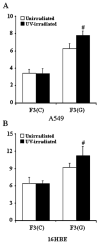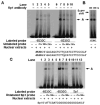A variant of the Cockayne syndrome B gene ERCC6 confers risk of lung cancer
- PMID: 17854076
- PMCID: PMC2441604
- DOI: 10.1002/humu.20610
A variant of the Cockayne syndrome B gene ERCC6 confers risk of lung cancer
Abstract
Cockayne syndrome B protein (ERCC6) plays an essential role in DNA repair. However, the Cockayne syndrome caused by the ERCC6 defect has not been linked to cancer predisposition; likely due to the fact that cells with severe disruption of the ERCC6 function are sensitive to lesion-induced apoptosis, thus reducing the chance of tumorigenesis. The biological function and cancer susceptibility of a common variant rs3793784:C>G (c.-6530C>G) in the ERCC6 was examined. We show that the c.-6530C allele has lower binding affinity of Sp1 by EMSA and displays a lower transcriptional activity in vitro and in vivo. We then examined the contribution of this polymorphism to the risk of lung cancer in a case-control study with 1,000 cases and 1,000 controls. The case-control analysis revealed a 1.76-fold (P= x 10(-9)) excess risk of developing lung cancer for the c.-6530CC carriers compared with noncarriers. The c.-6530CC interacts with smoking to intensify lung cancer risk, with the odds ratio (OR)=9 for developing lung cancer among heavy smokers. Our data constituted strong evidence that ERCC6 rs3793784:C>G alters its transcriptional activity and may confer personalized susceptibility to lung cancer.
Published 2007, Wiley-Liss, Inc.
Figures





Similar articles
-
ERCC6/CSB gene polymorphisms and lung cancer risk.Cancer Lett. 2009 Jan 8;273(1):172-6. doi: 10.1016/j.canlet.2008.08.002. Epub 2008 Sep 11. Cancer Lett. 2009. PMID: 18789574
-
The ERCC6 gene and age-related macular degeneration.PLoS One. 2010 Nov 1;5(11):e13786. doi: 10.1371/journal.pone.0013786. PLoS One. 2010. PMID: 21072178 Free PMC article.
-
The DNA repair gene ERCC6 rs1917799 polymorphism is associated with gastric cancer risk in Chinese.Asian Pac J Cancer Prev. 2013;14(10):6103-8. doi: 10.7314/apjcp.2013.14.10.6103. Asian Pac J Cancer Prev. 2013. PMID: 24289633
-
Novel frame shift mutation in ERCC6 leads to a severe form of Cockayne syndrome with postnatal growth failure and early death: A case report and brief literature review.Medicine (Baltimore). 2018 Aug;97(33):e11636. doi: 10.1097/MD.0000000000011636. Medicine (Baltimore). 2018. PMID: 30113454 Free PMC article. Review.
-
Cockayne Syndrome Group B (CSB): The Regulatory Framework Governing the Multifunctional Protein and Its Plausible Role in Cancer.Cells. 2021 Apr 10;10(4):866. doi: 10.3390/cells10040866. Cells. 2021. PMID: 33920220 Free PMC article. Review.
Cited by
-
Ultraviolet-B induces ERCC6 repression in lens epithelium cells of age-related nuclear cataract through coordinated DNA hypermethylation and histone deacetylation.Clin Epigenetics. 2016 May 26;8:62. doi: 10.1186/s13148-016-0229-y. eCollection 2016. Clin Epigenetics. 2016. PMID: 27231489 Free PMC article.
-
Whole Exome Sequencing reveals clinically important pathogenic mutations in DNA repair genes across lung cancer patients.Am J Cancer Res. 2023 Oct 15;13(10):4989-5004. eCollection 2023. Am J Cancer Res. 2023. PMID: 37970346 Free PMC article.
-
Molecular cloning and gene expression analysis of Ercc6l in Sika deer (Cervus nippon hortulorum).PLoS One. 2011;6(6):e20929. doi: 10.1371/journal.pone.0020929. Epub 2011 Jun 14. PLoS One. 2011. PMID: 21695076 Free PMC article.
-
The role of Cockayne Syndrome group B (CSB) protein in base excision repair and aging.Mech Ageing Dev. 2008 Jul-Aug;129(7-8):441-8. doi: 10.1016/j.mad.2008.04.009. Epub 2008 Apr 30. Mech Ageing Dev. 2008. PMID: 18541289 Free PMC article. Review.
-
Modifiers of (CAG)(n) instability in Machado-Joseph disease (MJD/SCA3) transmissions: an association study with DNA replication, repair and recombination genes.Hum Genet. 2014 Oct;133(10):1311-8. doi: 10.1007/s00439-014-1467-8. Epub 2014 Jul 16. Hum Genet. 2014. PMID: 25026993
References
-
- Brennan P. Gene-environment interaction and aetiology of cancer: what does it mean and how can we measure it? Carcinogenesis. 2002;23:381–387. - PubMed
-
- Butkiewicz D, Rusin M, Enewold L, Shields PG, Chorazy M, Harris CC. Genetic polymorphisms in DNA repair genes and risk of lung cancer. Carcinogenesis. 2001;22:593–597. - PubMed
-
- Cheng L, Spitz MR, Hong WK, Wei Q. Reduced expression levels of nucleotide excision repair genes in lung cancer: a case–control analysis. Carcinogenesis. 2000;21:1527–1530. - PubMed
-
- Cheng L, Sturgis EM, Eicher SA, Spitz MR, Wei Q. Expression of nucleotide excision repair genes and the risk for squamous cell carcinoma of the head and neck. Cancer. 2002;94:393–397. - PubMed
Publication types
MeSH terms
Substances
Grants and funding
LinkOut - more resources
Full Text Sources
Medical

